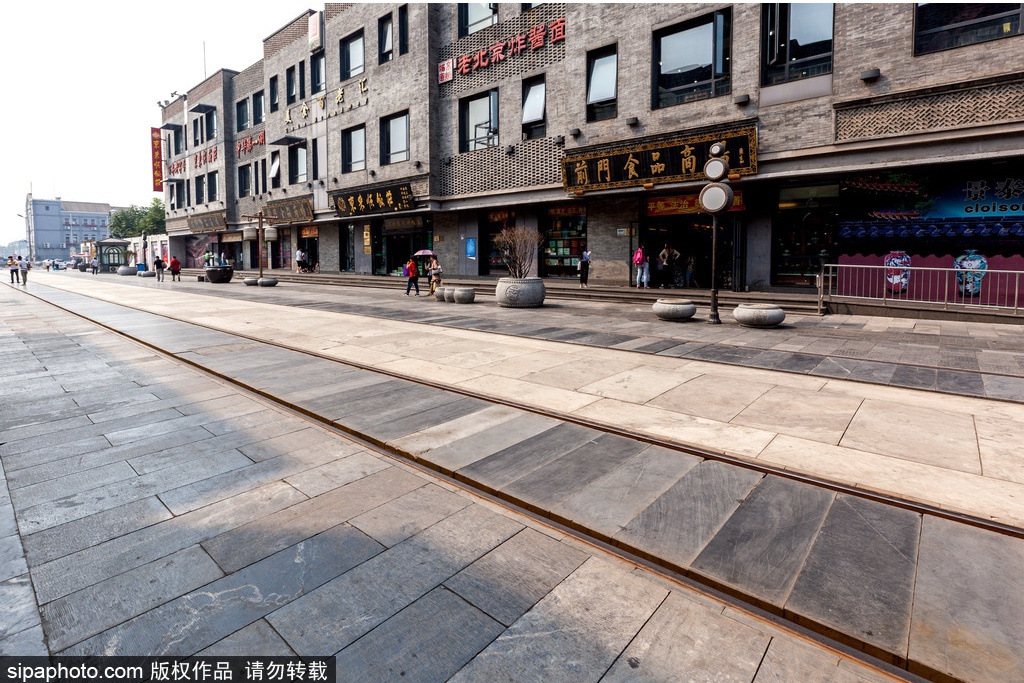Dashilan Street was a commercial center of Beijing more than five hundred and eighty years ago. The name Dashilan comes from the large gates built at either end of the street during the Qing Dynasty to prevent street crime at night and as a safeguard against riots by the local Han people against the Qing. The fences built here were quite peculiar and remained for a long time. In 1900, the entire street was burnt to the ground during the Boxer uprising before it again prospered from returning merchants.

Dashilan is situated on south of Tiananmen Square, west of Qianmen Dajie, where many century-old shops and restaurants are located. Here you can also purchase some traditional handcrafts. Bargaining is always needed. The old shops and small stalls located here are frequented by Beijingers.
Looking from the eastern end of the street, one might be misled by the two-storey facade and elaborately carved Baroque style pillars of a shop called Ruifuxiang.This is actually a 100-year-old Chinese silk and fabric store. This store provides an excellent tailor service at a reasonable price and also has ready made clothes.
A stone's throw to the west is Zhangyiyuan Teahouse. In olden times, tea drinkers would bicycle tens of kilometers just to buy a pack of tea there. If you are a tea lover, this is the place to find the finest tea from a variety of types such as: green tea, black tea, mint tea, jasmine tea, chrysanthemum tea and medicinal tea.
If there is one thing Chinese take more seriously than tea drinking it is health care, as may be seen from the three-storey Tongrentang Pharmacy which dwarfs other buildings in the vicinity. Even if you are in perfect health, you may still benefit from the magical effects of such tonics and remedies as pearl cream, ox gallstone pills and other elaborate concoctions once made for the Imperial court.
An old Beijing saying states: "A man is half poor without wearing good shoes". Two doors down from Tongrentang, Neiansheng Shoe Store is still making and selling their "thousand-layer cloth shoes" which are favored by old timers in Beijing.
Across the street is one of the oldest opera houses in Beijing: Guangdelou. It opened in the late 18th century, around the same time the Paris Opera House and Moscow's Grand Opera House were completed. Apart from its long history, it was once famous for the performance of Peking Opera masters and famous actors. Today, the old operas are rarely performed in their entirety but rather as compilations of selected scenes. For foreigners and Chinese alike, the most fascinating part of Peking Opera is the resounding style of singing, the many masks and the bright, colorful costumes.
Around
If you have already tried the Peking Duck of Quanjude on Qianmen Dajie, saunter a little further south to find : Duyichu Shaomai which is famous for its seafood and vegetable shaomai (steamed dumplings); Laozhengxing Shanghai Restaurant where authentic Shanghai food is served and Gongdelin Vegetarian Restaurant where vegetable and tofu are used to mimic the taste and appearance of meat and seafood dishes.
If you pass through the Xiaojiang Hutong near Duyichu, you may pay a quick visit to Yangping Provincial Guild Opera House. Originally built in the Ming Dynasty and rebuilt on several occasions since, it is now the largest wooden structure opera theater in Beijing. In the old days, its two-storey structure with sweeping cornices, lofty corridors, painted columns and carved Islamic window frames must have been an imposing sight to passers by. It is currently closed for renovations.
Following Zhushi Dajie to the west, you will come to the Jinyang Restaurant and Huguang Provincial Guild at Hufangqiao. Jinyang Restaurant is famous both for being the former residence of Ji Xiaolan, a minister of the Qing Dynasty and for the Shanxi style food it serves.
The Grand Opera House of the Huguang Guild Hall at the corner of Zhushi Dajie and Nanxinhua Jie is another jewel among Beijing's opera houses. Belonging to the provincial guild of Hunan and Hubei province, it was built around an open courtyard with five other halls. Special performances of Peking Opera and Kunqu Opera are staged in the opera hall on weekends. A huge sculpture of a four-color Peking Opera facial mask in front of the gate leaves visitors no doubt as to its function.
Making a further detour from Caishikou Dajie, you can zigzag through Yongqing Hutong to the north entrance of Lanman Hutong. Local residents will show you the exact location of Hunan Provincial Guild Hall (now the Lanman Hutong Kindergarten) where Mao Zedong stayed briefly.
Walking along the short alley from north to south, you will discover the charm of the red tiles, green eaves and lion shaped gate stones of the rich merchants, the carved brickworks decorating the windows and walls of the well-to-do families, and the grey tiles and walls of the houses of the common people.
Address: 5, Zhubaoshi, Qianmen Dajie Metro: Line 2 and get off at Qianmen station Opening Hours: all day



